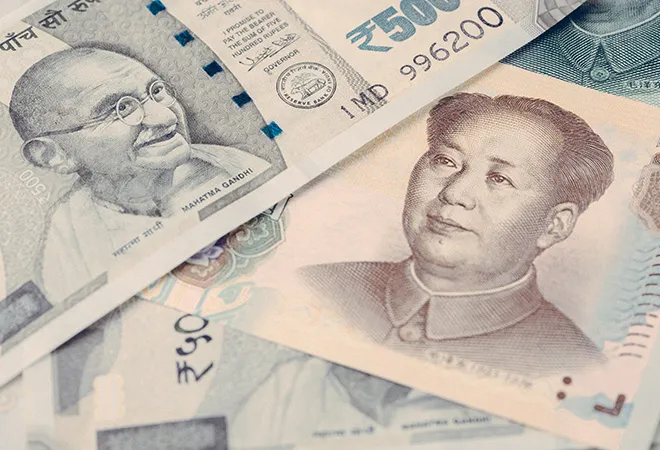
The important news in the currency market has been the rupee’s fall in terms of the dollar. The rupee has depreciated 3.9 per cent against the dollar in recent weeks. To some people, the rupee’s depreciation has a connotation of a weakening economy. But this may not be so. A depreciated rupee may be good for the economy as it can aid in boosting exports.
While it is true that foreign portfolio investors (FPIs) have been withdrawing $ 4.8 billion since the end of July from the Indian stock market, which could have been instrumental in the sharp fall in rupee’s value, it may not be indicative of anything more than solid faith in the strong dollar and investments in the US looking more attractive as compared to India, where the GDP growth has sunk to a six year low.
FPIs are forever looking for highest returns for their funds and keep moving their money from country to country. When the economic scene turns gloomy in the host country and there are signs of a slowdown — falling profits and low returns on investments — they make a beeline for the exit button.
Foreign direct investment is also affected by the volatility in the rupee’s value and they seek a stable currency because when they are trying to repatriate profits, a depreciated currency means less profits in dollar terms. It also means a hike in the costs of imported items from home countries for running their businesses in India. Spare parts and components are often imported by foreign companies from their home countries for factories established in India. Their managers coming from home countries would have to be paid more if the rupee depreciates sharply.
Foreign direct investment is affected by the volatility in the rupee’s value and they seek a stable currency because when they are trying to repatriate profits, a depreciated currency means less profits in dollar terms.
The Chinese yuan too has been falling in dollar terms, by 8 per cent recently, especially after the trade dispute between US and China. High tariffs have made Chinese goods uncompetitive in the US market. To retain the competitive edge, the Chinese government has allowed the yuan to slide against the dollar, breaching the 7 yuan to a dollar parity maintained over last 7 years. Chinese exports will now have an advantage of being cheaper in dollar terms. India is watching China’s yuan closely and does not want to fall behind it in the depreciation game. India also does not want China to gain a competitive edge in our markets.
The immediate advantage of the rupee’s depreciation will be felt by those receiving remittances from abroad. India receives one of the biggest remittances in the world at $80 billion from its huge diaspora abroad. The amounts received by individuals will now be more than before in terms of rupee. Now, that the rupee has sunk to a level of Rs 71-72 per dollar, It will help boost consumption by receivers of remittances which will be good for our consumer goods and the real estate sector. Indian remittances have traditionally gone into consumption and today it is consumption that is slackening. NRIs have been showing interest in acquiring real estate recently.
India’s exports will be cheaper in dollar terms, offering competition to Chinese exports in international markets. Our export growth has been flat for some years. Our neighbouring countries have been able to capture the gap left by China’s decline in trade with the US quite well because of their competitive prices. India’s transaction costs have remained high, making Indian labour-intensive exports uncompetitive.
India’s exports will be cheaper in dollar terms, offering competition to Chinese exports in international markets.
The IT service sector has much to gain from the rupee’s fall. IT services will be offered at cheaper rates which will boost demand and the repatriation of profits from Indian IT companies abroad like the TCS will be more in rupees with a depreciated currency. Similarly, the pharma and chemicals sectors will also get a leg up.
On the downside, there are many worries like the interest payments to service external debts by corporates. Indian companies have borrowed from foreign countries under External Commercial Borrowing scheme, allowed by the government to corporates and finance businesses, as interest rates have been low for many years in the EU and US as compared to India. India’s corporate’s external debt is at $41 billion (2018-19). The increase in interest payments due to the rupee depreciation will impact their already thin profit margins and affect their productivity growth and rate of return on investments.
India also imports many raw materials and intermediate goods that go into export production. The gems and jewellery business is dependent on imports of raw semi-precious stones, pearls and diamonds. These imports will cost more and the gems and jewellery business will face a setback. Already, it has been ailing because of the fall in global demand and rise in the price of gold.
If the rupee continues to fall, interest rates will have to go up which will not boost investment.
India’s dependence on imports of crude oil is also going to bring about huge problems. India imports huge quantities (80 per cent of its needs) and also exports refined petroleum products valued at $46.8 billion. The import price of crude oil will be much higher than before with rise in geopolitical tension in the Middle East, hence petrol and diesel prices will go up, which in turn will have an inflationary impact. If the rupee continues to fall, interest rates will have to go up which will not boost investment. Imports of edible oil from Malaysia will be affected by the rupee’s depreciation and cost more.
Needless to say foreign travel by Indians will cost more. Holidays will be more expensive for tourists. Their purchases of any gift items will cost more. For those who have children studying abroad, more money will be required to finance their studies. Servicing student loans for studies will become more expensive. In other words, there will be many disadvantages for the common person if the rupee falls further.
The government has forex reserves of around $400 billion. It can easily intervene in the forex markets by selling dollars which would increase their supply and arrest the rupee’s slide. But, it may not choose to intervene too much because a strong rupee may affect India’s exports which have recently registered a fall of 6 percent. Following China in this game is going to be important.
The views expressed above belong to the author(s). ORF research and analyses now available on Telegram! Click here to access our curated content — blogs, longforms and interviews.




 PREV
PREV


